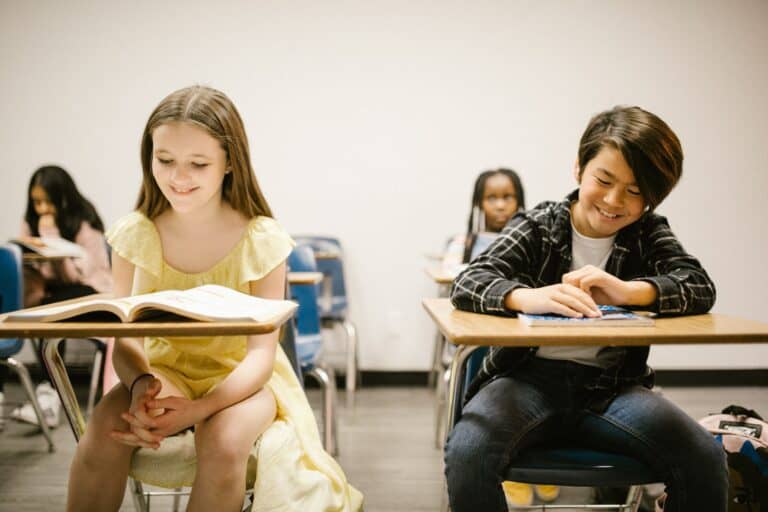How to Help Adolescents Navigate the “Digital Infinity”
Balancing life on and off “screen” is a defining project of what it means to be human in today’s tech-centric world. Questions abound: can you build fulfilling relationships fully on-screen? How “real” is your digital presence? How much do influencers influence your life? How do you appreciate the world in front of you when virtually you can be anywhere? How much is too much screentime?
These are questions adults are trying hard to figure out – while simultaneously answering them for their children. This is an inordinate, perhaps unprecedented, challenge for parents and educators, especially those of adolescents. And as each new report on teen mental health makes clear: the stakes couldn’t be higher.
But here’s what I see as the biggest issue: we aren’t talking honestly enough about the absurdity of the task. Instead, we are operating as if it is doable and expected for adults to effectively regulate an adolescent’s digital life. We need to step back and ask: is this even possible in the first place?
As an educator and researcher, I think the fundamental, and terrifying, answer to this question is no. Given that, we need a new strategy for teens and tech – and for the adults striving to protect them.
Long-term, I expect and hope that government regulation will be a critical piece of the solution; but for today, we could begin to develop a new strategy by answering two questions. First, why are we pretending that it is, in fact, possible to protect adolescents from the infinity of digital life? Second: what levers are in our control when it comes to helping adolescents manage these new frontiers, and how can we use them?
The Basic Challenge: Adolescence Meets Digital Infinity
When it comes to tech / life balance, boundaries are easier to draw in childhood – before kids have screens of their own, or while they are using highly regulated devices. But with adolescence comes what I think about as digital infinity.
Here’s what I mean: when I was in middle and high school, my world expanded according to the boundaries my teachers and parents set. You have outdoor recess but have to stay on campus; you can get ice cream but you only have five dollars; you can have Instant Messenger but leave the chatroom if a stranger enters. These lines were mostly visible: if a teacher saw you all off-campus at 10am, you needed to be accountable for that decision. The consequences were concrete: going into debt at the ice cream store meant an IOU, chores, and returning to pay with a big tip and an apology. And online activities mimicked analog life, so adults could regulate them with moderate confidence: don’t-talk-to-strangers applies online, too.
For kids today, the world expands according to their search terms, their peers’ digital behavior, and algorithms that respond to their every move. When a child gets a smartphone or a laptop – usually in late elementary or early middle school – the borders of their world blur. Suddenly, their lives become infinite: they can access an endless encyclopedia of real-time information (or misinformation), algorithms that don’t value their wellbeing serve them content, and peers in supersized social networks trade messages at record speed. Digital activities are not fully visible (a search or messaging history never tells the full story) and are too fast (absorbing newsfeed content takes milli-seconds) and too dynamic (new trends, norms, and platforms spring up overnight). As scary as it is to admit, they cannot effectively monitored by parents or teachers.
The Bigger Challenge: Adults Admitting the “Hydra”
Dr. Sanjay Gupta, Neurosurgeon, Chief Medical Correspondent at CNN, and parent to three teenage daughters, has an answer to the first question – why aren’t we talking about the impossibility of regulating digital infinity? – but it’s hard to hear. He writes that:
Talking about screens and limits makes me feel vulnerable. I constantly ask myself, am I doing the right thing? Am I being a good dad? […] As a doctor, I am used to having the answers – and the data to back up my beliefs – but because this is all so new, the studies haven’t been done […]. Even when we get a handle on one question, five new ones crop up. It’s like a hydra, the mythical water serpent that grows two new heads for each one cut off.
– Dr. Sanjay Gupta
I appreciate his naming the vulnerability that so many feel, and this instinct inspired him to interview his kids about their digital lives. Ultimately, their conversations confirmed his unease:
After having talked to my daughters and quite a few experts, I question whether we provided the proper guardrails. I would never toss my car keys to a 16-year-old with only a learner’s permit and say, ‘You’re on your own!’ But I wonder if I did the digital equivalent.
– Dr. Sanjay Gupta
I think he did. I think we all have – and that the biological context of adolescence only further complicates the issue.
Adolescence is a time when kids’ brains are “under construction,” writes Dr. Lisa D’Amour in her buzzy book The Emotional Lives of Teenagers. The “work” begins with the amygdala (which evaluates incoming information and generates emotions),then moves to the prefrontal region (responsible for planning, decision making, and maintaining perspective) (78). This means that when most children get their first smartphone, they are developmentally primed not to be able to make sense of their emotions or make reasoned judgments.
This has become normalized – but it’s nuts. At the precise moment when humans are at their most developmentally vulnerable, we give them access to a world that not even adults can manage.
There isn’t an alternative – adolescents should, of course, have access to technology – but let’s zoom out, name the Hydra, and agree that it’s ok for adults to feel vulnerable on this front. (Hey, @Brene Brown: could we get an on-shame-and-screentime TED Talk?).
In all seriousness, if naming the Hydra of teens and screens is the first step, the next is asking: if we can’t kill the Hydra, how can we tame it?
The First Line of Defense: Make face-to-face conversation less scary for teens.
In my work, I often give workshops at schools about how face-to-face conversations are a kind of insurance policy against the pace, divisiveness, and infinity of digital life for teens. If kids have better conversations, they’ll be more grounded in life off-screen and better able to make sense of digital infinity. Sometimes I draw parallels to the Computer Labs of the nineties: those were school-based programs spun up to teach students the basic technological skills they would need to compete in a computer age. I argue that today’s kids need Conversation Labs: school-based programs that explicitly teach students the communication skills they’ll need to thrive as humans in a tech-centric world.
Heads nod within minutes, as the logic here is both intuitive and research-backed: we all know that face-to-face conversation is the key to deep relationships, and that – as the world’s longest scientific study on happiness concludes – positive relationships lead to a good life. As MIT Professor Sherry Turkle has long since proved: “for an iPhone generation, conversation cures […] live conversation develops capacities like empathy and self-esteem.” And fresh studies from Authentic Connections focused specifically on K-12 schools show that students’ resilience levels are tied to the quality of their relationships with teachers, peers and parents and that positive relationships are the single biggest protective factor for teen mental health and wellbeing.
Here’s the catch: today’s teens avoid face-to-face communication (so do many adults). As a result, they are not developing the communication skills and interpersonal confidence they need to build these deep relationships – with adults and peers alike. The causes of this deficit are myriad and debatable (blame covid, social media, politics, parents!) but the reality is that today’s kids are scared of talking live – and, they struggle to deeply listen too.
This doesn’t need to be as doomsday as it sounds. Conversation skills are perfectly teachable, but we have to systematically teach them – and soon. At REAL Discussion, we believe that schools have a unique and powerful role to play here: teachers spend more focused face-to-face time with children than their parents do. In many kids’ lives, class discussions might be the only time when they engage in device-free, group conversation. But to rise to this challenge, teachers need new training and tools to explicitly teach, assess, and celebrate these in-person conversation skills. And parents deserve easy, authentic frameworks for continuing the “Conversation Lab” work at home.
The Second Line of Defense: Regulate Access to Screens (the kids want you to!).
This is obvious, and I won’t spend time on it except to say that even as research is still emerging about the precise effects of tech on executive function, attention management, and mental wellbeing, it’s clear that regulating access to screens is the most basic “preventative care” available for teens and screens. It looks different in different schools (put your phone in the basket, no cell phones in the cafeteria at meals, no open laptops without the teacher’s permission) and households (phones in the drawer before bed, no devices at the dinner table, no phones unless the car ride is longer than half-hour), and the permutations have understandably been written about ad nauseam. It’s not the whole answer, but making sure that adolescents retain some screen-free time is critical – and common sense. Kids roll their eyes, but research out of Harvard GSE shows that most teens have concerns about their own use of screens. While the conversation is still evolving about whether “addiction” is in fact the best term to describe “not being to turn it off” it is clear that many kids feel unable to control their use of technology – and by setting limits on tech access, adults can help.
The Third Line of Defense: Narrate your own (imperfect) efforts to achieve tech/life balance.
Popular wisdom suggests that adults need to model healthy screen habits for kids – and I think that’s true. But I would love to see adults narrate the challenges of managing their own tech/life balance, too. Tell your teen that you, too, have a screentime timer set – or you cringe each week when Apple pushes your screentime statistics to you. Make an announcement when you’re tearing yourself off Instagram to go start a Saturday and tackle a project “IRL” – instead of watching other people’s videos that capture their IRL experiences. When you go for a walk with your son and notice the leaves changing on a tree, direct his attention to it – and mention how not looking at your phone helped you see that. When you see an article or an exchange online that strikes you as hostile or untrue, debrief it. Make a point of waiting to sit down to dinner until you have finished the text you need to send. Use all these experiences as fodder for conversation about how tech is not bad, but it needs to be managed.
Sanjay Gupta’s daughters have wisdom for us all: “future generations will have to figure out how to control themselves, just as people do around temptations like chocolate and potato chips.” Allow your children to see how tech tempts you, too – and work together to cultivate IRL experiences that make resisting that temptation a little easier.
Helping the Helpers
We know that adolescence in a virtual world is at least as challenging as an in-person one. Today’s students are managing both – and they need our help.
But we adults need help, too, and it’s ok to say so. Adults who interact with adolescents – whether in the car, around the dinner table, in the classroom, or on the playing field – need tools and strategies to protect children from the vastness of the digital infinity. They need tools to help them develop the IRL relationships that can safeguard against some of the more distressing ramifications of a digital life.
We know that conversation is the mechanism through which these relationships are built. In-person conversation is a dying art, but it needn’t be. When endowed with the right tools, adults can help adolescents learn how to have a conversation – a real one, which can help make their infinite world feel a little more manageable.






